As the chapter on stage presentation in Greater Magic was written nearly fifteen years ago it's about time to do a spot of checking in view of the existing conditions of show business in Latin America today.
The full evening's illusion show in its present form is slowly going out of existence. At its best it is an anachronic medium of entertainment comparable to the opera or the zarzuela (Spanish light opera).
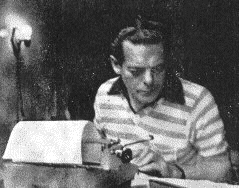
From 1910 until 1935 there was a South American vaudeville tour headed by Don Carlos Seguin. His headquarters was the Teatro Casino in Buenos Aires and his main representative was in Paris. The best variety acts in the world were brought from Europe and the United States for a six month's tour which included Rio de Janeiro, Sao Paulo, Montevideo, Buenos Aires and a few of the smaller cities in the Argentine Republic. When talkies came in, vaudeville went out and there never was sufficient talent in Latin America to warrant the continued upkeep of variety houses and topnotch acts were too expensive to import. However the legitimate theatres accepted magic shows on the same terms as stock companies and revues, so it was a question of forming a first class full evening's magic show or not working at all.
Latin America is a vast field comprising South and Central America, Mexico, the Carribean countries and one can include Spain; 22 nations all speaking the same language with the exception of Brazil. (And Portugese is not TOO different.)
One of the great disadvantages in touring South America is the great distances between cities. If it were possible to have one's own truck and trailer things would be ideal but the Pan-American highway is far from completed. In some parts of the Argentine and in northern Peru it is excellent but in most of the other countries it is practically impassable especially in the mountainous countries such as Chile, Bolivia, southern Peru, Ecuador, Colombia and Venezuela. In northern Colombia and Panama it is non-existent. From Argentine to Mexico one travels by train, bus. auto, plane, ship, river boats or trucks through vast plains, lakes, jungles, wild Indian country, over huge mountain passes considered the most dangerous in the world and through all sorts of climatic conditions from subzero to fierce heat.
In some places the theatres are modern, comfortable and in some cases even beautiful, but in most places they are pretty bad. In the smaller towns musicians are not to be had and the few that show up are terrible and one usually works to music that has all the soulful inspiration of a bilge pump. Modern stage lighting is unknown so one has to take a minimum of musicians and lighting equipment along.
In order to lick this situation one is forced to have a light, compact and easily set-up show. Had I learned this years ago I would have saved myself a lot of grief, but, as a young man I had the itch to be that mythical character, The World's Greatest Magician. I thought in my naive way that the solution lay in having more props than anyone else. So I built tons of illusions and the result was that I never did become the world's greatest magician and I found myself with an old-man-of-the-sea on my back that I couldn't get rid of.
When I built a new illusion it was mine to have and to hold until death us do part. Suppose one who has a show that consists of fifty pieces of baggage is entering a new country. These miracles are inspected and passed by the customs officials and a bond is put up for them. When you leave the country you still have to have those same fifty pieces or forfeit the bond.
There are times on a ship when you may desperately scheme to chuck a few crates overboard on a foggy night but then you realize that the stuff has been checked on board as well and it still remains all yours.
On the other hand if you wish to add a new illusion or some scenic effect up goes the total and you end up by being the "world's greatest" lost in a sea of crates.
The only practical solution is to make a radical change in the show in some country where you can get all the necessary materials, put all your faith in God. and grease the palm of some ambitious customs official as you leave the country happy in the knowledge that you have performed your greatest illusion, the vanishing of two tons of junk in one fell swoop.
I mentioned in "Greater Magic" that the old fashioned cyclorama which most of the old timers used was not suitable to Modern presentation because of its obvious limitations. Recently I have begun to favor the old cyc again but in a Modern, streamlined version.
The gaudy, although very attractive painted scenery that I have used till now has many drawbacks. It is heavy, needs constant retouching, is difficult to mask and in some low stages impossible to hang. Even when carefully folded for transportation the paint wears thin at the folds and when it is rehung you see the marks distinctly. I am now working on a new idea in which the old cyc plays an important part. Instead of the scenery going up I will have the changes made from the side in order to be able to work in picture theatres that have no grid. There are a lot of problems to be ironed out but when I have the new settings in working order and if they meet expectations I will give the readers of The Sphinx an outline of the idea with photos.
I am afraid I was a bit premature in some of my radical statements in "Greater Magic" but I was fifteen years younger then. I think it was Oscar Wilde who said something about the young being always ready to give their elders the full benefit of their inexperience. It eventually dawned on me that one man talking directly to an audience for over two hours is wonderful for the performer but insufferable for the public. I found a solution in bringing in a second character, the comedian, and enlarging the sketches. This enriched the dialogue and made it so much better theatre. It turned me into a light comedian and straight man. The comic does the slapstick with the pratfalls and the breakaway pants complete with the shot. Thus is the wheel of showbusiness in Latin America turned back to the Potash and Perlmutter era.
One of the happy results of this combination is my sketch. The Magic Bazaar. I play the part of the magic dealer and my eager client is the comic. You can see he is a poor slob who'll never be a magician as long as he lives but he insists on buying magic tricks and snafus everything even to getting the dealer-demonstrator fouled up. Finally the exasperated dealer has no other alternative than to vanish this outsized orangutan. The sketch requires two principals and has two small bits that any assistant can play. About twenty small tricks are streamlined into a comedy routine and it uses the De Kolta chair for the final vanish of the stooge. It is one of the outstanding successes in my show.
The success of this sketch led to others: Black Magic, The Haunted Window, The Enchanted Cabaret, The Eternal Triangle, The Two-Timing Magician, The Reversed Theatre, The Magic Circus, The Vengeance of Fu Manchu, Fifi of Paris, and the Gypsy's Curse. Some of these are talking sketches, some pantomime, while others have musical or dance motifs, but all have motivation, timing and rhythm. They are divided about equally into the two full evening shows. Between the sketches we do bits, small magic and some of the better known tricks and illusions.
In Greater Magic I mentioned the difficulty of finding good stooges and plants. I finally gave it up as it never struck me as good theatre in any case. The whole comedy routine of the old spirit cabinet depended on a good plant and finally, after many changes, I got fed up with it and changed the whole plot around. In its present form the laughing response is far greater than before as the part of the stooge is done by a professional comedian.
I would like to mention here that the blinding lights in eyes of the audience as formerly used in the black art routines is quite unnecessary. I use one (red) thousand watt border spot hung directly over the cabinet which amply lights the illusion and the actors but leaves the black clad assistant completely invisible even at a distance of three feet.
I use the word "cabinet" which is really a misnomer. My Haunted Window is not a cabinet in the sense that it is part of the stage setting. I feel that magician's cabinets are the biggest eyesores that were ever invented. They are usually ungainly, bulky, heavy and extremely antiesthetic. They look just what they are; tricky. Any reasonably intelligent person knows that one or more assistants can be concealed in such a monstrosity. How many unhappy husbands have been confounded when a mysterious Don Juan springs out from a simple wardrobe? Where is all the mystery then?
My Haunted Window illusion is just a variation on the old spirit cabinet routine. Both Maskelyne and Selbit used the old multiple door illusion. Selbit used it for his "Shadow People" illusion. Maskelyne used an ingenious system of mirrors in combination with his cabinet. The mirrors came up thru' a stage trap and was a very remarkable piece of magic but not practical for the road and quick setting. Mine is a much simpler version but not a patch on the Maskelyne illusion. However I have the old-man-of-the-sea on my back and have to sacrifice masterpieces for good forgeries.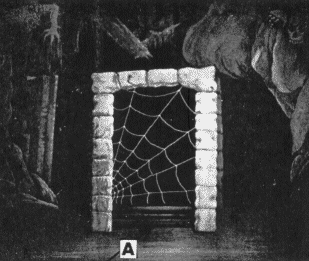
As can be seen by Fig. 1 it is constructed of three 3-ply boards fastened to a frame with wing-bolts. The side boards almost touch the floor to hide the wheels from view. When the curtain opens the illusion is in its place and is not turned around as I feel it incongruous to wheel a stone window around. The wheels are only used to bring the illusion on or off stage.
The boards are painted to imitate stone which gives the effect of the window being part of an old broken down castle which the scenery represents. The window curtains are black with white tape sewed on to give the effect of a huge cobweb. When the curtains are opened the effect is like brushing a cobweb aside.
The window has no back at all and when the curtains are opened one sees clear thru. The comedian wanders in and out of the window with a flashlight in his search for the ghost and thereby convinces the audience that nothing is concealed there. Nothing is mentioned about anyone Not being there and the audience convinces themselves which is so much to the good and better magic. This combination of setting and illusion facilitates things greatly and I believe that it will play a considerable part in future magic productions.
Note the frame "a" just below the platform. It is one of Okito's sound and clever inspirations. Some stages are bumpy and even have holes in them and when an illusion is wheeled on in a hurry and a wheel gets caught in one of these holes the leg of the illusion is apt to snap clean off. The Okito frame prevents this. A long bolt is passed down thru' the platform and the leg, and out thru the Okito frame where it is locked with a nut. The wheels are then bolted to the frame just a little to one side of the locking nut. I have never had a broken leg or wheel since using this device.
A prime headache in magic shows is tricks that are motivated by purely mechanical or electrical means. Most electrical devices let you down when you most need them, as do most clockwork devices. I saw a famous magician in Buenos Aires have a wrestling match with his Jumbo Rising Cards on his opening night. The damned thing just wouldn't work. I have tried to eliminate all but the most elementary mechanical movements from my show and even so things are not 100% foolproof.
Complicated lighting effects are also impossible in Latin-America if you have to depend on the house electrician. As I never learn and like things the hard way I had fourteen light changes when I first produced my Black Magic illusion. That included the effect machines and the U.V. I found later that I could get the same effect with five changes.
Down here some towns have A.C. others D.C. Some fool towns have 150 volts, another has 220 or 110 and in one place, so help me, Hannah! they had 440. So with a small switchboard of my own and a small transformer (5000W) I now use 110 A.C.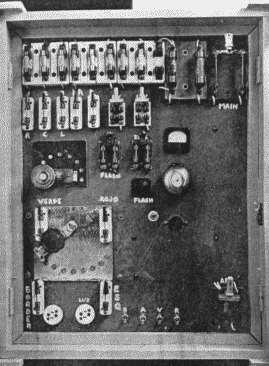
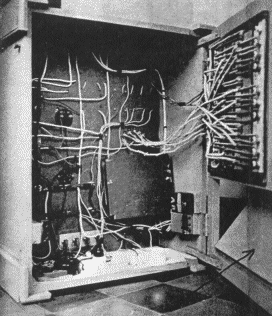
The switchboard (Fig. 2) takes care of all the lighting effects a magic show needs. It has circuits for U.V., red, white and blue floods, signals for the spot-light man, arcs, various outputs for bells, magnesium flashes, effect machines and other gadgets. The floods can be dimmed by the upper variable resistance on the switchboard. The lower variable resistance takes care of four center baby spots which can be dissolved from red to green or viceversa. This resistance also operates and dims the effect machines and border floods.
In the Haunted Window sketch the scene opens in red light which dissolves to green bringing out the hidden monsters painted in the scenery. By throwing the small switches below the resistance it dissolves the green into the floating skeletons (effect machine) and then dissolves into the red border spot that lights the window from above as I mentioned previously. There is also an outlet for dimming or dissolving side or back lights using the same resistance.
Fig. 3 shows the back of the switchboard open. If any magician wants the hook-up I'll be glad to oblige. As I made the switchboard myself it will never pass the American Underwriters Laboratory but for my purpose down here it is a scientific masterpiece.
The average magic show in Latin-America still uses that sickening opening that seems to be a mania. When the curtain rises one sees those horrendous gold fringed magic tables usually cockeyed. Upon them are an unartistic display of tubes and boxes with phoney chinese characters and unhappy dragons painted on. From these hellish props are produced a number of depressing silk handkerchiefs, some antiquated feather dusters which the magi fondly believe to be roses, a few tarnished gold fish, some silly folding boxes which usually refuse to open, and other things so dear to the heart of the pistol-packing fraternity. Having touched upon this topic I would like to write a little about a man for whom I have a great feeling of admiration, Dariel Fitzkee. I strongly advise anyone who intends to perform a full evening's illusion show to read "Showmanship For Magicians." Fitzkee's advice on stage presentation and magic in general is excellent. I read his book as a tonic when I get that slack don't-give-a-damn feeling and with his permission I wish to quote him and even elaborate a bit on his wise teachings.
1. "Take the number of exhibitions of magic that are given throughout the country in a single day--fully 75% of the performances are poor according to modern entertainment standards. Another 24% are mediocre.
Fitzkee feels that he is being "conservative" when he estimates that not more than one percent can be called smart and modern. I would say that on a world basis a full 99% have an obnoxious affluvia. (Col:Am: It stinks!)
2. "There is too much tolerance for magicians as a group." I think Mr. Fitzkee is much too polite to say that they get away with murder.
3. "The Thurston show was at one time known as the most valuable property in show business--no magic show even remotely approaches that status now. Obviously, magic itself is not to blame. It attained this distinction once--when its method of presentation was geared and attuned to the times."
Any comment I might make on this pearl of wisdom would be to gild the lily. I can only say that the title of this article is DON'T BLAME MAGIC. Thurston had something when he called his show "An American Institution." But that was the time before the American Public was saturated with entertainment, and magic in particular, as they are now.
4. "'If your principal can so present a magic show that it once more appeals to the masses, he will be greater than Thurston, or Herrmann, or Houdini.' This remark was made by a nationally prominent theatre executive to one of our agents during my experience with the International Magicians In Action show. He added, 'And he'll make a fortune'."
One may argue here that it is easy to write a book and give theoretical advice but it's practical experience that counts. I read about the presentation of the Doll House illusion that they did in that International Magicians In Action show and I asked permission of Mr. Fitzkee to use it. He kindly sent me the complete plan with dialogue and many helpful suggestions and offered me the use of anything that had been published in his book. With some slight changes, but using his basic idea, this presentation has been a success in my show for five years.
5. "Marco, of Fanchon and Marco, said when he saw the show, 'In its present form it is a good show--definitely a good one.' Remember, he was speaking as an experienced theatre man, rather prejudiced against magic than interested in it, as so many professional theatre men are. 'It can be made a great show, I think, by addition of a voice, perhaps the right type of girl numbers in keeping with the idea already there, and a few minor changes here and there'." Typical dealer's ad: Anyone can do this trick in three minutes without practice. (We pay the postage.)
6. "Truly, the words uttered by the average magician during the average performance constitute the most dismal palaver ever inflicted upon an audience. --extreme economy of talk and movements is IMPERATIVE. --many magic shows suffer from poor material, poor delivery, fumbling, lack of precision, slow tempo, out-of-date ideas."
Magic in itself has very little emotional appeal. It can be pepped up with good music, motivation, rhythm, proper lighting, staging and direction. In the great majority of magic shows it is just one goddam trick after another.
7. "The performance of magic is a MINOR branch of the entertainment field."
It once had a very high standard and by gearing it to modern standards it could be made a major branch.
8. "These (magic) secrets aren't so damned valuable. There are few of them that can't be reasoned out by a man of fairly logical analytical ability. It must be repeated again. THE SECRET IS NOT IMPORTANT. The ONLY thing that is important is its favorable impression upon the majority of the spectators." How very true! I have found it necessary many times to push the TRICK into second place and give PRESENTATION preference to get the right audience appeal. Magic is a very tiresome performance when extended to any length, and a Modern audience tires very easily. The average full length talkie runs about an hour and twenty minutes and has action. suspense and motivation. The average magician tries to entertain for two and half hours practically alone on the stage.
Thank you, Mr. Fitzkee, and if I used many of your ideas in the writing of this article I can only say that we both think exactly alike.
I think it of great importance to cultivate an individual style. Teacher Fuess of Phillips Academy expresses it well when he says, "Every superior artist, though he may begin by IMITATION, eventually develops his own individual style. --rules and systems will avail him little. Only his personality can make him successful." "Showmanship should never show. But it you haven't got it, you have the kiss of death."
One of the oddest facts of show business is that it is far easier to work in a big city than in a small town. The toughest thing in show business is the narrow minded audience of the stix. One would think they would delight in seeing the big town productions but it's just the reverse. I have found by experience that the bigger the city, the bigger the cinch for a big magic show.
What's new in magic? Frankly, nothing. What's new in the theatre, T. V., radio and the movies? Frankly, damned little. Most everything they do is a variation on an old theme with a new presentation or angle. It is unjust when they pick on magic as being the only branch of show business behind the times. The solution lies at hand. Do as they do. There is always a public rat-race to see something new. Do they get it in other fields of entertainment? I'll say they don't. They get a camouflaged version of something as old as the hills. Westerns and Civil War pictures by the carload with a few cloak and dagger opuses thrown in. The eternal triangle and the third man theme worked to death. Is there anything more exasperating than the average radio show with those highly artistic singing commercials? They plug the latest song until it drives you nuts and then put on a modern arrangement of "Josephine, I'll Take You up in My Flying Machine." Abbott and Costello pulled every ancient gag from the hat since Joe Miller crossed the street to the other side, and got away with it. Are these new comics Dean Martin and Jerry Lewis funny, or am I losing my sense of humor? Even the mighty Chaplin slipped badly in his last pictures when he switched good slapstick for bad homespun philosophy. TV? That's going to be the biggest stinker of them all. How can they expect any human being or group of humans to turn out QUALITY and ORIGINALITY from eight in the morning till midnight, day after day and year after year. What do you think these hams are going to do? Just switch it around a little and polish up the presentation. Magicians never learned that. The pistol barked, the girl flew out of a cabinet and the house fell in. As Taylor said, "I think the problem of keeping the adult mind occupied is probably the greatest challenge we face." TV uses the sausage machine technique to solve this problem.
All we magicians have are the seventeen basic principles to be played as a virtuoso executes a theme. But there is a difference between execution and outright murder, and the magic show of to-day is murder in the first degree. So get a variation of your theme and remember what a sucker John Q. Public is --and brother, you're in!
For some obscure reason business and art don't mix. The agents will tell you that a beautiful and artistic presentation is sometimes bad box office. "Business is business." The guy who invented that phrase ought to be shot. It's true that few creative artists are good business men, but who the hell wants to haggle over pennies. Can anything be more boring than, as Harold Maine so aptly puts it, "You buy, you sell, you gouge, and all under a cloak of amiability. You think of volume, of seven kinds of overhead, or gross and net or net and gross.--(Theatre Managers) are sly but you must be slyer and all the while pretend that neither of you is sly." There are lots of guys who delight in adding up tremendous columns of figures, get one of those and let him do the figuring.
As far as the artistic end is concerned you don't have to be a Michelangelo either. All he got for his pains was his neck out of joint from painting the ceiling of the Sistine Chapel. Far from appreciating the really great things it seems that the show world delights in mediocrity. Most of the stuff they feed them from the TV and movie screens is mediocre. Most artists are mediocre no matter how much build up they get from their press agents. There are very few really outstanding artists in the world to-day and most of the big name artists are just fair-to-middlin' and that includes me. However, I do try to sugarcoat the pill so that the average theatregoer can get it down his silly gullet.
Here are a few recipes for pills.
Dealers make good small magic but their stage illusions are not too good. They cannot be blamed for this because they sell a stage illusion once in a blue moon. I learned from Okito to build illusions with an eye on transportation. You'll have to use some of Paul Smith's Theory of Foresight when you build your illusion.
As Okito used to say when he wasn't satisfied with construction: "I see it coming on!", and one could visualize a tremendous disaster on the stage.
Most illusions are built on a hit or miss basis. I found it a good scheme to make a rough first model out of old packing crates and rough boards. This model can be torn apart and cut down until the minimum desired size is obtained. Then a first not-too-good model is built and the wrinkles ironed out and a practical method of packing is figured out.
If the effect on the audience warrants the illusion's inclusion in the show then the final model can be built with care and the best materials. A well made illusion lasts a lifetime. My sofa illusion was built by Okito thirty years ago and in spite of constant use it is in perfect working condition. No illusion is ever really finished, as one finds room for improvement and changes and corrections for stupid mistakes that you could kick yourself for. Most of the best ideas come during construction.
Most important is packing. Props should never be packed too loose or jammed in. Leave a little space all around and fill the gaps with crushed newspapers. The really bad damage to props is due to joggling of trunks and crates in trucks and trains and above all the rough handling of loaders and those arch-criminals, the stevedores. Very rarely do props get damaged in the theatre.
Crates should he as light and as small as possible. The main reason that illusions have to he made on a breakdown plan is that baggage is measured by the metric ton on ships and not by dead weight and who wants to pay for air space?
My crates are wooden frames with 3 ply sides, bottom and lid. If these crates get holes knocked in them they easily can be repaired with a small piece of 3 ply and some brads which are doubled over inside and hammered down acting as rivets. If you don't care for expense then a practically indestructible crate can be made by covering the 3 ply with canvass well glued on. Keep away from oversize crates and use two smaller ones if the illusion needs it. I don't use locks on crates but prefer to bolt the lid on with four bolt-hinges. The lid is removable. Hinges and locks are broken off in notime.
Paint all the crates one color with a distinguishing mark in one corner. Then a good coat of waterproof varnish. Valspar is ideal for this. My trunks are numbered from one to twenty five and my crates from 101 to 125. We know by the number which is a trunk and which is a crate and besides it's good advertising when they load the baggage and they see a crate numbered 125. They think you have a giant production but actually fifty pieces is not excessive for this type of show. Private wardrobe trunks are not numbered.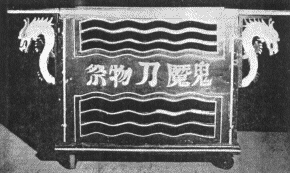
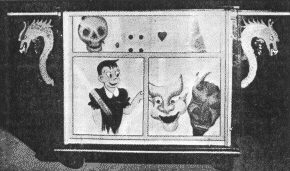
In order to keep weight down I sometimes double an illusion for my second programme. That is, I use the same prop but for a different effect. Fig. 4 shows the "sawing a woman" table and Fig. 5 shows the same prop with a false front and top which makes it the counter in the Magic Bazaar sketch. Fig. 6 is a pagoda used for the girl doing a striptease behind a white sheet with the comedy payoff of the comic in her place when the sheet is yanked open. In Fig. 7 it is the house used in a quick change routine for the Eternal Triangle pantomime sketch. A new front curtain and a few. changes inside and presto! a new illusion. This prop has no back to it which takes it out of the "cabinet" class.
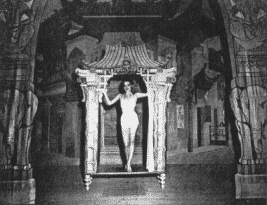
The Atomic Woman illusion is another light affair consisting of two cloth lanterns, a stand and a folding base. A very flashy stage display and closing number which is packed in one small crate and an equally small trunk. (Which is filled with rubber fruit as the stand is hollow.)
Another advantage of small and easily set up illusions is that one man can do the work that took four men to do previously and he does it in half the time.
A couple of years ago I went with Sam Horowitz to see the Cantarelli show in Buenos Aires. It was typical of the old magic shows of 1900. He showed me his baggage and it was unbelievable. He needed fifteen seven ton trucks to cart that junk around. One glass tank for the production of two bathing belles had a crate which had to be left in the lobby of the theatre as it wouldn't go thru' the doors. The tank was made of heavy sheet metal and thick glass and the crate was made of some heavy tropical wood. When packed the contraption weighed over two tons and the effect on the audience was nil. He only played in B.A. as the smaller towns couldn't afford to pay for the transportation and many stages were not strong enough to support the tank full of water. Cantarelli has since retired and has a duck farm in Sao Paulo, Brazil.
When Chang played the Avenida in B.A. this year he had over a hundred and twenty pieces of baggage. He told me himself that he didn't use the half of it but didn't have the heart to throw it out; trunks full of old clothes and books and useless apparatus. If he only carried the show that he presented in the Avenida and stored the rest he would have about what I carry. Says Taylor: "When people lived in houses they generally had attics. Their purpose: a storage place for things so dear to their owners' hearts that they couldn't be thrown away." Let us consider the excess trunks as being the attic of the show.
With the Raymond show we didn't use half the stuff we carted around and there were crates and boxes which never were opened because the locks were rusted fast and the keys lost. In one customs house we forced the locks off a big crate and found it empty. Someone had stolen the prop years before. Instead of chucking the crate out Raymond kept it in the hope that some day he would have an illusion to fill it.
The Okito show was the lightest and most practical show I ever saw. He carried twenty pieces and didn't have ten pounds of excess baggage. When he was thru' with an illusion he either destroyed it or sold it. It was a perfect, well run show, always in excellent repair and served as a model for mine. I think he is the most practical all around magician of them all. His forethought and planning were a delight.
All this harping on reducing weight and size may sound highly exaggerated to some readers but due to rising costs of transportation, small stages and the demands of union employees it is a vital factor in the existence of a show in Latin-America to-day. This must hold good in other parts of the world as well.
The cutting of the big illusions opened another source of income for my show. When I had those tremendous cabinets I could only work in theatres with big stages. In some cases the larger movie houses were more popular but the stage was small. Now I can work on any stage and have room left over. Some of you who saw my show in New York may remember those two giants I had, the Fashion Shop and the Spirit Cabinet. They took up all the stage space available.
The first to get the ax was the spirit cabinet. Formerly it was a complicated, multiple doored contraption seven feet square, and for what? To hide two little girls? After reading Jarrett's book I realized what a lot of horse sense that man has. His book may be badly written and vulgar but it is one of the greatest books on illusions ever to be published.
As the illusion is a black art affair and as black is infinity. I reduced the depth to 18 inches. All the wooden doors were thrown out and light steel tubes to hold black felt sides took their place. The "cabinet" idea was eliminated and the back left open so one has a clear view thru. One girl does the work of two and the method of concealment was altered. The front stayed the same so from an audience point of view they saw no change. From three large crates the packing was reduced to HALF of one of the original crates and there is room inside for a couple of curtains.
After the success of this operation we got after the rest of the show and in four months reduced the dead weight by fifty percent and the cubic weight by over two thirds, and Jarrett was vindicated.
The small stage holds no terrors for us now. The complete show stands flat against the wall or picture sheet and with the "doubling" of the illusions we have worked on stages so tiny as to be an illusion in itself.
Then we divided the show into the BIG show and the BABY show. This means we can send a good portion of the baggage to the capital city and work the smaller towns with the baby show, which consists of eighteen pieces and takes one hour to set and another to pack. It has eight large stage illusions and the rest small stuff. A good show, but without the time killing sketches this couldn't be done.
Another important point is to have everything packed in the crate that belongs to that particular illusion. If an accessory is packed in another trunk it may be forgotten and when the show is set up the accessory is two hundred miles away. Complete in one crate also simplifies the packing and things are not forgotten and left behind.
In closing I would like to give the circus performer's viewpoint of magicians in general. They don't like em.
Magic shows and the circus have a lot in common. They are both "family' shows and both use the same flashy, highly exaggerated advertising and depend a lot on sensationalism.
I have in the show a family of four circus people. They were born and bred in a tent. One of the boys, PINKY, is my comedian and a good showman. He never dreamed of working in a magic show because circus people have a special antipathy for magicians. They look upon them as the fakers of show business.
Circus people have to rehearse all their lives and most of them do dangerous acts in which broken legs and necks are quite common. They earn their money the hard way. Says Pinky, "Take these magicians. They never rehearse anything as most of their stuff is mechanical. They shoot a gun and a dame opens a door and jumps out, or they produce something from a tricky looking canister. They are the biggest frauds and fakers in show business."
That brings us back to where we came in. Magic isn't to blame. Something's got to be done about it, and, my dear fellow gun-men, something shall!
